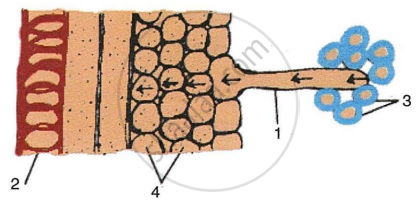Advertisements
Advertisements
प्रश्न
Differentiate between the following:
Plasmolysis and Deplasmolysis.
उत्तर
| Plasmolysis | Deplasmolysis | ||
| 1. | In this, the protoplasm of the cell shrinks away from the cell wall. It results in the flaccid condition of the cells and the plant. | 1. | In this, the protoplasm of the cell swells up and touches the cell wall. It results in the turgid condition of the cells and the plant. |
| 2. | Caused due to exosmosis. | 2. | Caused by endosmosis. |
| 3. | It takes place when a plant cell is kept in a hypertonic solution. | 3. | It takes place when a plasmolysed celI is kept in a hypotonic solution. |
| 4. | It results in the flaccid condition of the plant. | 4. | It results in the turgid condition of the plant. |
APPEARS IN
संबंधित प्रश्न
Give scientific reasons : Balsam plants wilt during mid-day even if the soil is well watered.
The state of a cell in which the cell wall is rigid and stretched by the increase in volume due to the absorption of water is called.
Give reasons for the following:
If you sprinkle some common salt on grass growing on a lawn, it is killed at that spot.
Distinguish between the following:
Flaccid condition and turgid condition
Mention whether the following statement is true (T) or false (F) and give an explanation in support of your answer.
Soaked seeds burst into three seed coats.
Give Technical Term for the following.
A cell in a fully extended condition.
Mention, if the following statement is True or False. If false rewrite the wrong statement in its correct form:
Flaccidity is the reverse of turgidity.
Fill in the Blank
Wilting and drooping of leaves is due to loss of ________.
Multiple Choice Question:
When cell is fully turgid, which of the following will be zero?
The figure given below is a diagrammatic representation of a part of the cross-section of the root in the root hair zone. Study the same and then answer the questions that follow:

- The parts labelled as 1, 2, 3 and 4 are:
- Root hair, Xylem vessel, Soil particles, Cortex respectively.
- Xylem vessel, Soil particles, Root hair, Cortex respectively.
- Root hair, Xylem vessel, Cortex, Soil particles respectively.
- Cortex, Soil particles, Xylem vessel, Root hair respectively.
- The process that enables the passage of water from soil into the root hair is:
- Diffusion
- Active transport
- Osmosis
- Passive absorption
- The kind of force which exists between a liquid and any surface is called as:
- Cohesive force
- Adhesive force
- Capillarity
- Suction force
- The kind of force between the same kind of liquid molecules is:
- Capillary force
- Transpirational pull
- Adhesive force
- Cohesive force
- Sometimes exudation of water occurs from the margin of the leaves in the early morning or night. It is termed as:
- Transpiration
- Guttation
- Bleeding
- Osmosis
